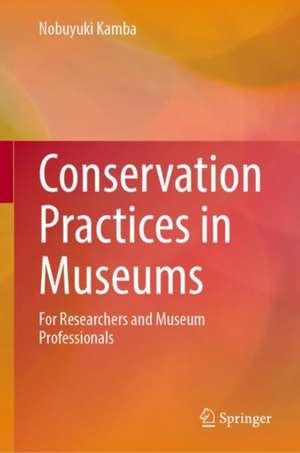Conservation Practices in Museums: For Researchers and Museum Professionals
Autor Nobuyuki Kambaen Limba Engleză Hardback – 3 feb 2022
The author addresses the current global trend of preserving rather than repairing cultural heritage at museums and emphasizes its importance.
Preț: 1109.16 lei
Preț vechi: 1352.63 lei
-18% Nou
Puncte Express: 1664
Preț estimativ în valută:
212.26€ • 230.49$ • 178.30£
212.26€ • 230.49$ • 178.30£
Carte tipărită la comandă
Livrare economică 23 aprilie-07 mai
Preluare comenzi: 021 569.72.76
Specificații
ISBN-13: 9784431569084
ISBN-10: 4431569081
Pagini: 182
Ilustrații: XIII, 182 p. 93 illus., 86 illus. in color.
Dimensiuni: 155 x 235 mm
Greutate: 0.45 kg
Ediția:1st ed. 2022
Editura: Springer
Colecția Springer
Locul publicării:Tokyo, Japan
ISBN-10: 4431569081
Pagini: 182
Ilustrații: XIII, 182 p. 93 illus., 86 illus. in color.
Dimensiuni: 155 x 235 mm
Greutate: 0.45 kg
Ediția:1st ed. 2022
Editura: Springer
Colecția Springer
Locul publicării:Tokyo, Japan
Cuprins
Significance of Conservation of Cultural Heritages in Museums.- Diagnosis of Museum Environment and Collections.- Environment and Preventive Conservation.- Deterioration and Remedial Conservation.- Environmental Protection and Role of Museums.- Education and Disseminate.
Notă biografică
Nobuyuki Kamba received his Ph.D. from the Tokyo National University of Fine Arts and Music in 1997. He started his career as a conservator at the restoration laboratory of the Sokei School of Fine Art, then became an associate research fellow and an associate professor at the Museum Science Department of the National Museum of Japanese History in 1984 and 1992, respectively. He was head of the conservation section at the Tokyo National Museum in 1998–2015.
In 1985 he joined the International Center of Conservation in Rome as a research fellow by obtaining a UNESCO Fellowship. In 1989 he served in The Courtauld Institute of Art, University of London, as a research fellow of the Japanese Ministry of Education.
He has focused on preventive conservation in the museum and the practical conservation of museum objects, and his current work includes establishment of a primary care system for museum objects and development of disaster preparedness. He is a member of the Japan Society for the Conservation of Cultural Property, the International Institute for Conservation, and the International Council of Museums. He has published many articles concerning conservation science, and as a freelance conservator, he is currently engaged in a mission to preserve the dignity of objects and their authors and owners.
In 1985 he joined the International Center of Conservation in Rome as a research fellow by obtaining a UNESCO Fellowship. In 1989 he served in The Courtauld Institute of Art, University of London, as a research fellow of the Japanese Ministry of Education.
He has focused on preventive conservation in the museum and the practical conservation of museum objects, and his current work includes establishment of a primary care system for museum objects and development of disaster preparedness. He is a member of the Japan Society for the Conservation of Cultural Property, the International Institute for Conservation, and the International Council of Museums. He has published many articles concerning conservation science, and as a freelance conservator, he is currently engaged in a mission to preserve the dignity of objects and their authors and owners.
Textul de pe ultima copertă
The author introduces conservation science and management of cultural heritages in museums. In particular, a comprehensive conservation study and practical techniques are described. Aspects such as examination and diagnosis of cultural heritage by scientific data recording of humidity, luminosity, intensity of vibration and shock, among others, are introduced. Preventive and remedial conservation with X-ray imaging and X-ray fluorescence and other risk-control methods are also explained. The author provides basic theories based on a scientific view for the methods introduced in this book. They can be compared with those used at other museums, and readers can employ them to adapt and improve their methods. Today, maintaining smooth internal communication is key for scientists and curators with different academic backgrounds and from different departments working together on conservation projects at the museum.
The author addresses the current global trend of preserving rather than repairing cultural heritage at museums and emphasizes its importance.
The author addresses the current global trend of preserving rather than repairing cultural heritage at museums and emphasizes its importance.
Caracteristici
Offers conservation measure examples for diagnostics, prevention and remediation used at Tokyo National Museum Explains how to maintain environmental conditions at museums to avoid degradation Introduces methods of remedial treatment of cultural heritage with minimum impact
